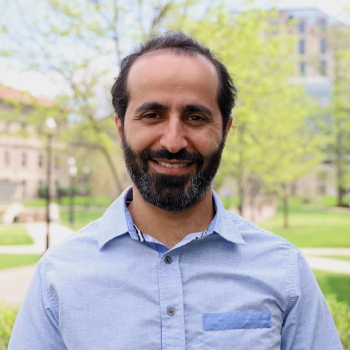Ahmad El Hellani, PhD
Assistant Professor
Environmental Health Sciences

“The distance between cities is always small, and the distance between countries is getting smaller. Centuries of science brought us closer to each other. I hope the scientific data I generate at EHS can benefit my fellow citizens in Columbus, Ohio, the U.S., and far beyond, reaching my distant village, Younine. I strive for equity in both data generation and data reception.”
Biography
Dr. El Hellani is an organic/analytical chemist who went from fundamental organometallic chemistry research to being interested in the assessment of human exposure to toxicants from various sources, especially tobacco products. He studies tobacco emissions in a controlled analytical lab using smoking machines, in a clinical lab using real-time sampling devices, and in a chamber lab for the assessment of secondhand emissions. His work could be the first line of toxicity assessment of tobacco emissions that may inform in vitro, in vivo (animal models), and biomarker of exposure and biomarker of potential harm studies. His work is interdisciplinary by nature and benefits from collaboration with colleagues with a broad range of backgrounds in environmental sciences, toxicology, engineering, psychology, behavioral science, epidemiology and medicine.
Dr. El Hellani recently received funding ($1.4 million) from the NIH National Institute of Drug Abuse (NIDA) and the FDA Center for Tobacco Products (CTP) to validate "Nicotine Flux" (i.e. rate of nicotine emission) as a potentially powerful tool for regulating nicotine delivery from electronic cigarettes. This project utilizes cross-disciplinary analytical and clinical lab methods to test the relevance of nicotine flux to nicotine delivery. The project seeks to answer a long open question about the impact of the freebase/protonated nicotine ratio on the drug delivery profile and subjective effects.
A better understanding of nicotine delivery, and hence addiction potential, of e-cigarettes and other tobacco products, can provide much-needed evidence to develop regulations that help mitigate risk from tobacco products.
Education
- PhD
- Chemistry, Université Paris-sud, Paris, France
- MS
- Organic Chemistry, Lebanese University, Beirut, Lebanon
- BS
- Chemistry, Lebanese University, Beirut, Lebanon
- MA
- Philosophy, Lebanese University, Beirut, Lebanon
- BA
- Philosophy, Lebanese University, Beirut, Lebanon
Research interests
Environmental health, tobacco products, tobacco emissions, tobacco control, analytical chemistry, inhalation toxicology and environmental risk assessment.
Select publications
- A El-Hellani, TL Wagener, MC Brinkman. Reengineering Addiction – The Tobacco Industry’s Potential Response to a Nicotine Standard for Cigarettes. New England Journal of Medicine 2024, In Press.
- A El-Hellani, A Adeniji, HC Erythropel, Q Wang, T Lamb, VB Mikheev, I Rahman, I Stepanov, RM Strongin, TL Wagener, MC Brinkman. Comparison of emissions across tobacco products: A slippery slope in tobacco control. Tobacco Induced Diseases 2024, doi: 10.18332/tid/183797.
- A Adeniji, R El-Hage, MC Brinkman, A El-Hellani. Non-targeted Analysis in Tobacco Research: Challenges and Potential. Chemical Research in Toxicology 2023, 36(11), 1656–1665.
- A El-Hellani, E Hanna, M Sharma, R Blohowiak, P Joseph, T Eid, H Nadim, R El-Hage, R Salman, N Karaoghlanian, A Adeniji, S Salam, F Talih, M Elbejjani, A Breland, T Eissenberg, A Shihadeh, SR Baldassarri, S Talih. Nicotine flux as a powerful tool for regulating nicotine delivery from e-cigarettes: protocol of two complimentary randomized crossover clinical trials. PLOS One 2023, 2023; 18(9): e0291786.
- YJ Cho, MC Brinkman, A Hinton, JD Nshimiyimana, T Mehta, A Adeniji, K Norton, A El Hellani, TL Wagener. The sweet spot study—Developing e-liquid product standards for nicotine form and concentration to improve public health: Protocol for a randomized, double-blinded, crossover study. PLOS One 2023, https://doi.org/10.1371/journal.pone.0291522.
- A. El-Hellani, A., R. El-Hage, R. Baalbaki, R. Salman, S. Talih, A. Shihadeh, N. A. Saliba. Free-base and protonated nicotine in electronic cigarette liquids and aerosols. Chemical Research in Toxicology 2015, 28(8), 1532.
- Talih, S., R. Salman, R. El-Hage, N. Karaoghlanian, A. El-Hellani, N. Saliba, A. Shihadeh. Effect of free-base and protonated nicotine on nicotine yield from electronic cigarettes with varying power and liquid vehicle. Scientific Reports 2020, 10(1):16263.
- Talih, S., R. Salman, R. El-Hage, E. Karam, N. Karaoghlanian, A. El-Hellani, N. A. Saliba, T. Eissenberg, A. Shihadeh. Might Limiting Nicotine Concentration Result in More Toxic Electronic Cigarette Aerosols. Tobacco Control 2021, 30, 348-350.
- O Ardati, A Adeniji, R El-Hage, R Salman, M El-Kaassamani, A Yassine, S Talih, M Hourani, N Karaoghlanian, A Breland, T Eissenberg, NA Saliba, A Shihadeh, A El- Hellani. Impact of Smoking Intensity and Device Cleaning on IQOS Emissions: Comparison with an Array of Cigarettes. Tobacco Control, 2023, tc-2022-057802.